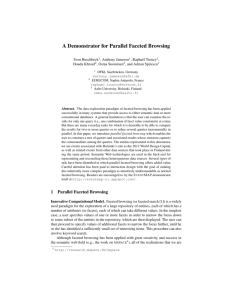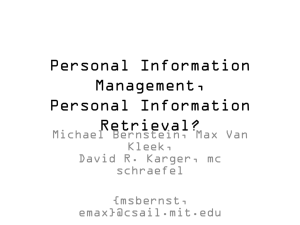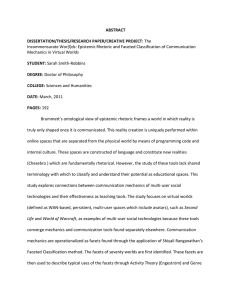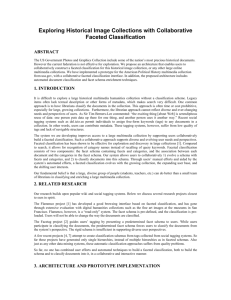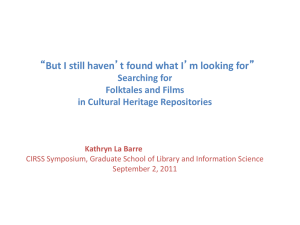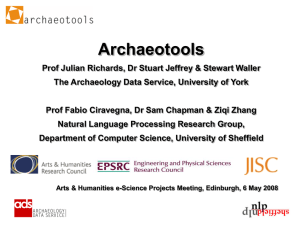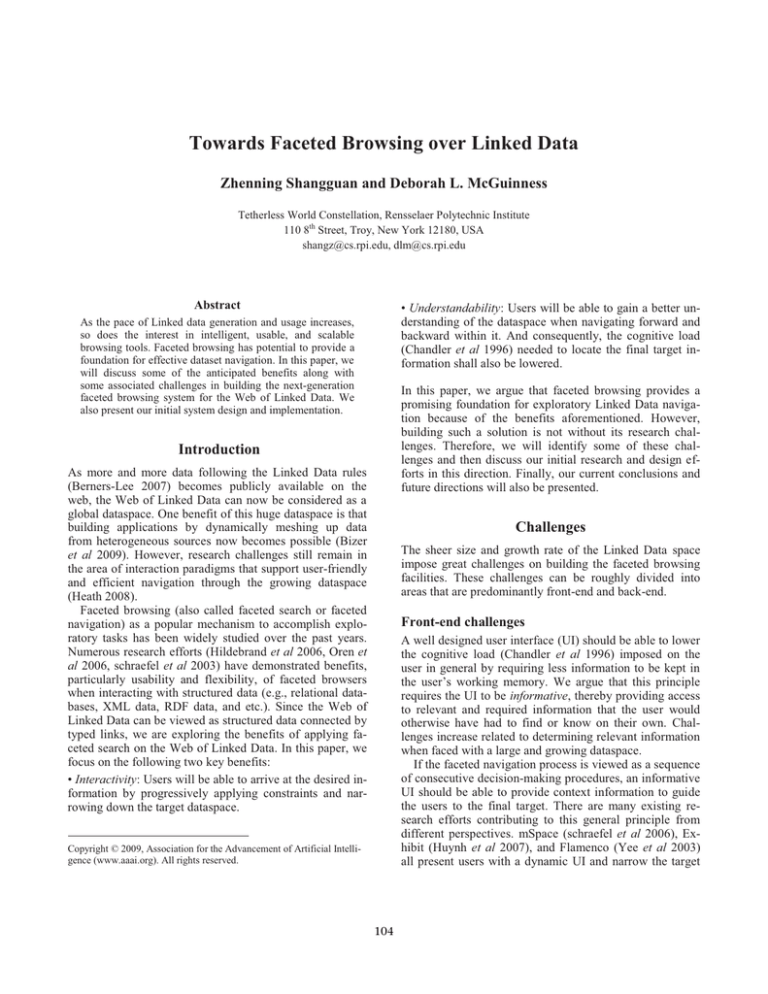
Towards Faceted Browsing over Linked Data
Zhenning Shangguan and Deborah L. McGuinness
Tetherless World Constellation, Rensselaer Polytechnic Institute
110 8th Street, Troy, New York 12180, USA
shangz@cs.rpi.edu, dlm@cs.rpi.edu
Abstract
• Understandability: Users will be able to gain a better understanding of the dataspace when navigating forward and
backward within it. And consequently, the cognitive load
(Chandler et al 1996) needed to locate the final target information shall also be lowered.
As the pace of Linked data generation and usage increases,
so does the interest in intelligent, usable, and scalable
browsing tools. Faceted browsing has potential to provide a
foundation for effective dataset navigation. In this paper, we
will discuss some of the anticipated benefits along with
some associated challenges in building the next-generation
faceted browsing system for the Web of Linked Data. We
also present our initial system design and implementation.
In this paper, we argue that faceted browsing provides a
promising foundation for exploratory Linked Data navigation because of the benefits aforementioned. However,
building such a solution is not without its research challenges. Therefore, we will identify some of these challenges and then discuss our initial research and design efforts in this direction. Finally, our current conclusions and
future directions will also be presented.
Introduction
As more and more data following the Linked Data rules
(Berners-Lee 2007) becomes publicly available on the
web, the Web of Linked Data can now be considered as a
global dataspace. One benefit of this huge dataspace is that
building applications by dynamically meshing up data
from heterogeneous sources now becomes possible (Bizer
et al 2009). However, research challenges still remain in
the area of interaction paradigms that support user-friendly
and efficient navigation through the growing dataspace
(Heath 2008).
Faceted browsing (also called faceted search or faceted
navigation) as a popular mechanism to accomplish exploratory tasks has been widely studied over the past years.
Numerous research efforts (Hildebrand et al 2006, Oren et
al 2006, schraefel et al 2003) have demonstrated benefits,
particularly usability and flexibility, of faceted browsers
when interacting with structured data (e.g., relational databases, XML data, RDF data, and etc.). Since the Web of
Linked Data can be viewed as structured data connected by
typed links, we are exploring the benefits of applying faceted search on the Web of Linked Data. In this paper, we
focus on the following two key benefits:
• Interactivity: Users will be able to arrive at the desired information by progressively applying constraints and narrowing down the target dataspace.
Challenges
The sheer size and growth rate of the Linked Data space
impose great challenges on building the faceted browsing
facilities. These challenges can be roughly divided into
areas that are predominantly front-end and back-end.
Front-end challenges
A well designed user interface (UI) should be able to lower
the cognitive load (Chandler et al 1996) imposed on the
user in general by requiring less information to be kept in
the user’s working memory. We argue that this principle
requires the UI to be informative, thereby providing access
to relevant and required information that the user would
otherwise have had to find or know on their own. Challenges increase related to determining relevant information
when faced with a large and growing dataspace.
If the faceted navigation process is viewed as a sequence
of consecutive decision-making procedures, an informative
UI should be able to provide context information to guide
the users to the final target. There are many existing research efforts contributing to this general principle from
different perspectives. mSpace (schraefel et al 2006), Exhibit (Huynh et al 2007), and Flamenco (Yee et al 2003)
all present users with a dynamic UI and narrow the target
Copyright © 2009, Association for the Advancement of Artificial Intelligence (www.aaai.org). All rights reserved.
104
dataset leveraging user click information. One common
characteristic of these systems is that they all employ a
single-focus paradigm in which the target information and
the facets are pre-defined by the system developers (e.g.,
the online newsfilm archive in mSpace1). Thus, the changing facet values can be viewed as the most significant context information that helps users in their decision making.
Beyond these single-focus systems, there are also multifocus faceted browsing tools like Humbolt (Kobilarov et al
2008) and Freebase Parallax2 that enable users to pivot or
refocus to different target datasets. Therefore, these systems provide additional context information in the form of
paths traversed and dynamically generated facets. This not
only enables the user to be aware of his current position in
the dataspace, but also provides the capability of returning
to a previous decision to follow a different path. However,
ideal solutions to generate these additional context information remains a great research challenge because extra
computation might be needed given the huge dataspace we
are facing.
Although these faceted browsing systems provide an informative and responsive interface to the user, they are all
limited as they either do not scale well to large datasets or
only handle a fixed dataset. Most of them can be viewed as
faceted browsers targeting a fixed structured dataset that is
either light-weight or independent from other datasets.
Therefore, their benefits begin to decrease when dealing
with datasets consisting of very large sets of interconnected
entities. Unless they evolve, they are unlikely to address
large web-scale datasets.
er of the servers. However, numerous challenges remain
for back-end technologies to truly support scalable Linked
Data browsing. For example, appropriate mechanisms to
rank the entities taking the semantics of the typed links into
consideration may greatly facilitate populating the UI of
the faceted browser by generating facets that are most relevant to the target information.
Initial System Implementation
Our system is under active development as of this writing.
Currently most of our work is focused on design and implementation of the user interface, aiming at addressing the
challenges discussed in the previous section. Key features
of our current interface design include:
• Non-directional Facets: We do not provide directional
associativity between facets as mSpace does. Instead, a
non-directional paradigm is used in which different facets
have equal significance. Using non-directional facets in a
Linked Data faceted browser might bring about intensive
computation because sometimes it may be necessary to recompute the facets and their values depending on the user
selection.
• Facet Filters: In many existing systems, facets are limited
only to the properties of the target dataset. However, there
is no reason that a facet itself cannot be described by other
facets. Such facets-of-facets are called indirect facets. We
implement indirect facets as filters on direct facets and we
refer to these as facet filters. In this way, we can avoid facet chains of arbitrary length and facet cycles discussed in
(Clarkson et al 2009).
• Paging: When a SPARQL query returns too many results
to be displayed within one screen, paging techniques are
used to show different subsets of the result set. Currently,
since we only retrieve data from SPARQL endpoints, paging is well supported by using the LIMIT and OFFSET
modifiers in the SPARQL query.
Back-end challenges
When faced with Linked Data at web scale, scalability becomes a major concern. The interactions between the users
and the faceted browsing systems often generate multiple
SPARQL queries, sometimes with arbitrary join, aggregation, and filtering operations (Erling et al 2008). It remains
an open research question on how to evaluate these complex queries at web scale under critical time constraints.
Some recent research efforts are beginning to address
these issues. Hartig et al (Hartig et al 2009) proposed an
online approach to query the Web of Linked Data by traversing RDF links during run-time to discover data that
might be relevant to the query. In contrast, there are also
research efforts on federated query mechanisms over distributed data sources that are cached in a central data store.
Erling and Mikhailov (Erling et al 2009) discuss various
aspects of SPARQL query evaluation techniques used by
the Virtuoso Cluster Edition over a large corpus of linked
data, including runtime inference, partial query evaluation,
and identity reasoning. These approaches all try to solve
the scalability issue either by suitable pre-fetching and
caching strategies or by increasing the computational pow-
Figure 1 shows one experimental UI of our prototype. The
data is retrieved from a SPARQL endpoint backed by Jena
TDB3 and Joseki4. The current layout is similar to that used
in most of the existing systems: the focus dataset is displayed in the center panel, while facets are presented on
the right and from top to bottom.
To implement an interactive user interface, we use
Google’s Web Toolkit5, which is convenient for building
optimized cross-browser Ajax applications. Currently we
also have a helper Java Servlet to issue SPARQL queries
against SPARQL endpoints that are publicly available. We
currently fetch results in XML format, which are then
parsed to populate the user interface.
1
3
2
4
mSpace Demo: http://mspace.fm/
Freebase Parallax:
http://www.freebase.com/labs/parallax/
Jena TDB: http://jena.hpl.hp.com/wiki/TDB
Joseki: http://www.joseki.org/
5
Google Web Toolkit: http://code.google.com/webtoolkit/
105
Bizer, C., Heath, T., Berners-Lee, T. 2009. Linked Data - The
Story So Far. International Journal on Semantic Web and Information Systems (IJSWIS).
Heath, T. 2008. How Will We Interact with the Web of Data?
IEEE Internet Computing, 88-91.
Hildebrand, M., van Ossenbruggen, J., Hardman, L. 2006. /facet:
A Browser for Heterogeneous Semantic Web Repositories. International Semantic Web Conference. 272-285.
Oren, E., Delbru, R., Decker, S. 2006. Extending Faceted Navigation for RDF Data. The 5th International Semantic Web Conference (ISWC2006), 559-572.
schraefel, m.c., Karam, M., Zhao, S. 2003. mSpace: interaction
design for user-determined, adaptable domain exploration in
hypermedia. AH 2003: Workshop on Adaptive Hypermedia and
Adaptive Web Based Systems, 21-235.
Figure 1 Prototype User Interface
Chandler, P., Sweller, J. 1996. Cognitive load while learning to
use a computer program. Applied cognitive psychology, vol. 10,
no. 2, pp. 151-170.
Conclusion and Future Work
In this paper, we outlined some of the key challenges, both
front-end and back-end, of building a faceted browsing
system over the Web of Linked Data. Our initial efforts to
build such a system and address some of these challenges,
highlighting some front-end issues, are also presented. Our
design and implementation is evolving and a future release
is expected to be online by symposium time for public test
and evaluation.
There are various aspects that we consider are worthy of
investigation in our future work. We plan to approach these
aspects from both front-end and the back-end.
• Front-end: We intend to add features that will further improve the UI and facilitate user decision-making. For example, we plan to support facets with hierarchical structure, e.g., geographic locations, by showing a tree view of
the parent-child relationship within a single facet. We also
plan to investigate how to combine the single-focus and the
multi-focus paradigm, with the former offering the ability
to narrow the data space as quickly as possible, and the latter being able to help explore the data space as widely as
possible. Additionally we plan to carry out a user study of
both qualitative and quantitative nature to evaluate and refine our user interface design.
• Back-end: Currently our prototype system is only able to
fetch data from SPARQL endpoints using RESTful web
services over HTTP. As a further step, we are beginning to
study how to effectively retrieve data published on the
Web exploiting the knowledge of data publication subject
to the Linked Data rules. Moreover, additional work on
scalability is required and we plan to investigate appropriate strategies related to pre-fetching and caching to improve performance.
schraefel, m.c., Wilson, M, Russell, A, Smith, D. A. 2006.
mSpace: improving information access to multimedia domains
with multimodal exploratory search. Commun. ACM, vol. 49, no.
4, pp. 47-49.
Huynh, D. F., Karger, D. R., Miller, R. C. 2007. Exhibit:
lightweight structured data publishing. 16th World Wide Web
Conference (WWW2007), 737-746.
Yee, K., Swearingen, K., Li, K., Hearst, M. A. 2003. Faceted metadata for image search and browsing. Proceedings of the 2003
Conference on Human Factors in Computing Systems (CHI
2003), 401-408.
Kobilarov, G., Dickinson, I. 2008. Humboldt: Exploring Linked
Data. Linked Data on the Web Workshop (LDOW2008) at
WWW2008.
Erling, O., Mikhailov, I. 2008 Towards Web Scale RDF. 4th International Workshop on Scalable Semantic Web Knowledge
Base Systems (SSWS2008).
Hartig, O., Bizer, C., Freytag. J. 2009. Executing SPARQL Queries over the Web of Linked Data. 8th International Semantic
Web Conference (ISWC2009).
Erling, O., Mikhailov, I. 2009. Faceted Views over Large-Scale
Linked Data. Linked Data on the Web (LDOW2009).
Clarkson, E., Navathe, S. B., Foley, J. D. 2009. Generalized formal models for faceted user interfaces. Proceedings of the 2009
Joint International Conference on Digital Libraries (JCDL 2009).
References
Berners-Lee, T. 2007. Design Issues: Linked Data.
http://www.w3.org/DesignIssues/LinkedData.html
106

